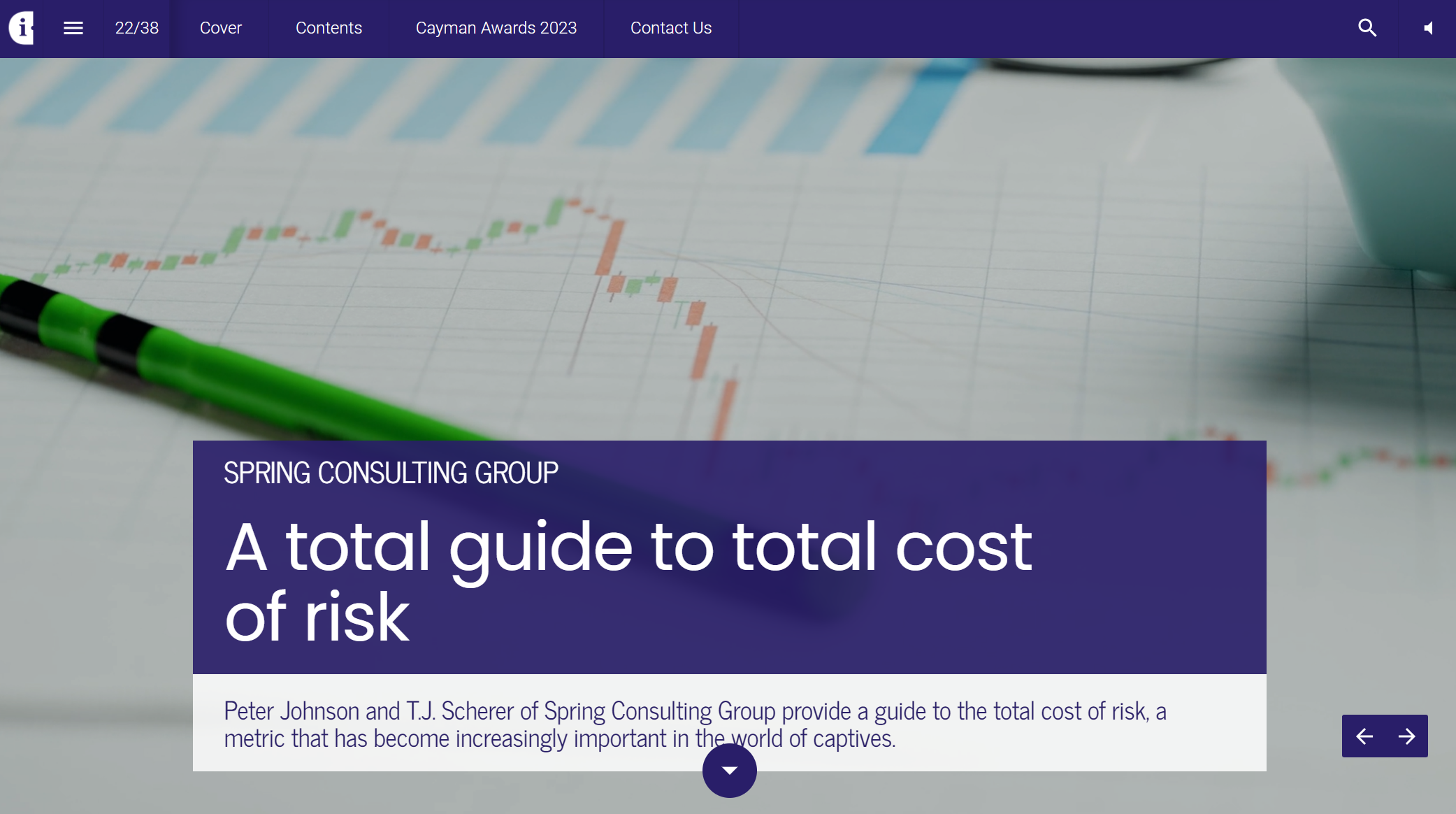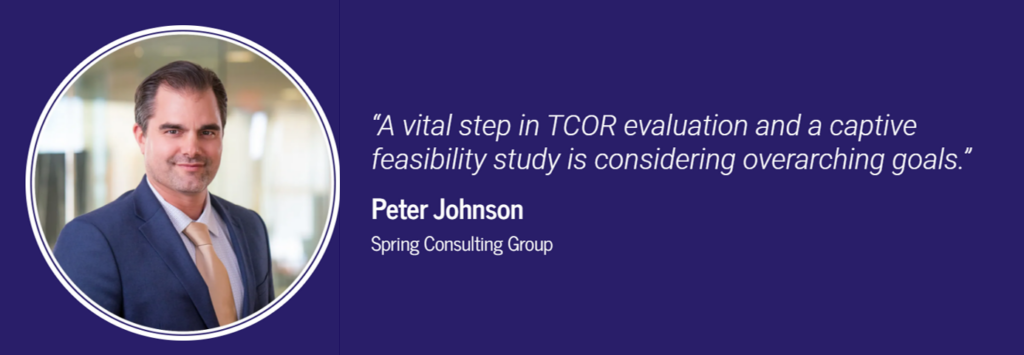Captive International Cayman Focus 2024: A Total Guide to Total Cost of Risk

People
Topics
Share
As Seen in Captive International’s Cayman Focus 2024
Total cost of risk (TCOR) is a buzzword in the insurance space, but it is a metric that carries significant operational weight, and can mean different things depending upon the organisation. There is no tried and true approach to TCOR, but we have gleaned valuable insights after consulting on the topic across a range of companies and risk profiles.
Leveraging those insights, we are sharing here a foundation for framing TCOR at your organisation, keeping in mind common dos and don’ts we have come across.
What is TCoR?
It’s important to start at the beginning. While there are various definitions out there, the International Risk Management Institute (IRMI) states that TCOR is the sum of all aspects of an organisation’s operations that relate to risk, both the cost of managing risks and the cost of losses incurred. These costs typically fall into the following categories:
- Retained (uninsured) losses and related loss adjustment expenses
- Risk control costs
- Transfer costs
- Administrative costs
More sophisticated risk management programmes may have internal risk control costs, whereas for other organisations these may be embedded into what is paid to a carrier with the goal of controlling loss.
Commercial insurance premiums are a prime example of a TCOR driver, representing what you are paying to transfer certain costs to the commercial or reinsurance market. Even for organisations with a captive, which is known to save organisations money in the long term, a risk transfer premium is still happening from the parent company to the captive.
Further, whether or not a captive programme is in place, most companies, especially those on the larger side, still retain a portion of their risk on their corporate balance sheet (eg, cyber deductible).

Building your TCoR
What constitutes TCOR varies across industries and company but regardless it can be backed by sophisticated risk management models as well as simpler calculations.
From a broad perspective, commonly overlooked considerations when it comes to tracking TCOR include:
- Beyond the frictional carrier or captive out-the-door premiums, other items budgeted for on the insured side such as safety programmes, loss control, and bonus programmes should be evaluated for inclusion or exclusion. If they are tracked within a captive premium (as is typically the case with loss control), such items are captured already so a company needs to be cognisant of not double-counting.
- Investment and underwriting income. Generally captives are priced to earn underwriting income and also earn investment income on the held assets to pay for unpaid claims. This income should be accounted for, which results in a lower TCOR.
- Softer costs such as risk management or safety personnel should be assessed for inclusion. Overall, consideration beyond obvious face-value expenses and including ancillary factors across the company provide a more robust calculation. Actuarial estimates of claims should be utilised for validation. Avoid relying solely on loss runs as this creates volatility because the third-party administrator (TPA) is typically only booking case reserves in the incurred claim estimates without factoring in the actuarial incurred but not reported development.
- Evaluation dates and look-back periods provide for quality tracking and the generation of trends, and should be assessed at various points in time. This is important when trying to compare the costs of various programmes related to budget and cash flow.
Perhaps most important is the need for year-over-year consistency regarding what is included in TCOR and what is excluded.
Who uses TCOR?
TCOR is meaningful to different stakeholders depending on the company, but these key audiences have important use cases for TCOR as follows:
- Risk managers leverage TCOR to show how they are approaching risk management and demonstrate how the company should retain risk, either through a captive premium or another method, as well as recommend what portion of risk should be transferred.
- Finance/accounting departments use TCOR to stress test and illustrate how much the organisation can afford and then plan for budgetary items that should reduce stated risk.
- Property and casualty (P&C) brokers care about TCOR because it enables them to benchmark and perform retention analyses in order to optimise programmes and mitigate volatility for their clients. TCOR allows them to make an apples-to-apples comparison year over year.
Trends and best practices
TCOR should not be touted simply because it sounds good. It needs to be grounded in analytics, formal reviews, and comprehensive reporting that outlines how TCOR is arrived at and what it means for your organisation. For large companies, TCOR may be factored into bidding, procurement, and contract processes. For smaller companies, there may not be enough critical mass to validate a self-funded approach, which means you’re more susceptible to market conditions and capacity.
From an organisational standpoint, TCOR plays a significant role in (i) accountability and compliance; (ii) making sure all assets, certificates of insurance, and contracts are listed; (iii) employees are accounted for; and (iv) there are no gaps in coverage that could change TCOR unexpectedly at the end of the year.
A vital step in TCOR evaluation and a captive feasibility study is considering overarching goals. If your company is looking to stay at cost, then moving to a captive may not always be the best play and you may be better off in the commercial market. This is why, as part of a TCOR analysis that is embedded within a feasibility study process as a means to reduce risk, alternative retentions in the market should be evaluated and the different scenarios to determine whether or not a captive makes the most sense outlined.

Other pieces of TCOR wisdom we have gathered over the years include:
- Fluctuations will happen from year to year, but some of the more volatile components are captive income and retained claims.
- A common misconception is that by increasing retention, lowering limits, or both combined, a reduction in TCOR will automatically occur. This may be true but is not necessarily so, as these practices could also expose the company to more risk than anticipated and that loss potential may not be appropriately projected.
- Consider this: with cyber and umbrella coverage becoming expensive for companies, let’s say you drop cyber entirely and lower limits to reduce TCOR by 5 percent. But then there’s a $3 million loss within that layer that would have been covered by policies you no longer have, so even though your budgeted TCOR went down by 5 percent, your realised TCOR increased by 10 percent due to the new loss.
- Analysis should consider different scenarios: what could happen, versus a straight-line evaluation.
- Ensure that at the time of increasing or decreasing a limit or removing a policy altogether, all parties agree to this move and it is documented to avoid questions after the fact.
- Benchmarking TCOR should be taken with a grain of salt, as practices are varied and factors such as captive versus no captive, geographic risk class differences, treatment of risk management admin costs, inflation and payroll may be working behind the scenes and can prohibit a direct comparison between two different organisations.
Conclusions
TCOR is complicated, but it is important to take a wide view of all the pieces of the puzzle, and then find the correlations and mitigation strategies available through the buying process. Captives need to understand how to budget for TCOR, how to build it at your organisation, and then how to interpret it year over year.
Strong TCOR practices can lead to improved risk management, smoother claims processes, and overall lower costs, especially for growing companies. A thoughtful TCOR approach serves to unify all your insurance stakeholders, from risk managers to CFOs, in understanding insurance spend and ultimately the total cost of risk.


